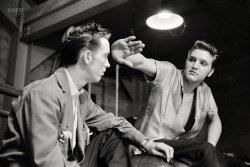
MAY CONTAIN NUTS

Search Shorpy
SHORPY ART

Framed or unframed, desk size to sofa size, printed by us in Arizona and Alabama since 2007. Explore now.
Join and Share
Ad-Free Shorpy
Shorpy is funded by you. Patreon contributors get an ad-free experience.
Learn more.

Recent comments
- Complicated then, forgotten now
- Bryan-Stevenson
- Skinny is as skinny does
- How do you rest in peace
- Riding the footboards
- Alas, hidden from view
- Baldwin Diesels
- Exclusive pump
- Bananas, Oysters and Smokey Joe
- Details, Details
- What's that building to the left of the tower?
- Coal Barges
- Bromo-Seltzer
- Inner harbor
- The Basin
- What a headache!
- Giant stepladder?
- Yeah, it was cold
- Love those coats
- Link & Pin Days Remnant
- Baldwin 62303
- Baldwin VO-1000
- Cold
- No expense spared
- Tough Guys
- What's your hurry, where's your hat?
- Sheriff's Signature
- Relocated in the Eighties
- Lost in Toyland
- And without gloves
Member Photos
The Shorpy
Print Emporium
Print Emporium
Search Shorpy
Search results -- 30 results per page
- Filling Station: 1924
- ... and products.
(The Gallery, Cars, Trucks, Buses, D.C., Gas Stations, Natl Photo) ... Posted by Dave - 08/07/2012 - 10:11pm -
![Filling Station: 1924 Washington, D.C., 1924. "Havoline Oil Company." View full size. National Photo Company Collection glass negative, Library of Congress.
Early Chassis Dynamometer? Looks like they lock down the automobile and then the drive wheels power a pump. The pressure is measured on the gauge on the "gasometer" in the background.
DynamometerThe device is a chassis dynamometer.
The dyno operator has his hand on the brake lever (Prony brake). He's either measuring horsepower and trying to relate it to engine condition or using the dyno to load the motor and collect/measure blowby somehow for the same purpose.
I wonder if this was a "special occasion" or if there was some other reason the dyno operator had so many helpers?
Mechanic Shade TreeThat's a honey locust in the foreground (note the seed pods). Memories of cleaning the pods off the driveway and yard as a kid. The tree also has huge thorns.
Special Occasion?It could be this was a demo of the device. The words on the gasometer seem to be announcing its purpose a bit too loudly for normal garage use.
Havoline Oil?The sign says Texaco, not Havoline.
[The Havoline sign is at top right. - Dave]
HavolineHavoline is Texaco's brand name for its oil and products.
(The Gallery, Cars, Trucks, Buses, D.C., Gas Stations, Natl Photo)](https://www.shorpy.com/files/images/11933u.thumbnail.jpg)
- Filling Station: 1910
- ... fountain is gone though, probably replaced by a nearby gas station.
"For Medicinal Use" Rooney Malt Whiskey ad in the ... Posted by Dave - 08/15/2012 - 3:52pm -
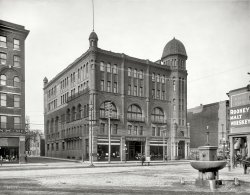
- We're the Nuts: 1970s
- ... Mass., sometime around 1977. Smokes were 57 cents and gas was 56. Taken for a photography class with a 4x5 view camera. View full ... right, a '63 Valiant. I'll take either one, too.
BP Station With a little oil spill in front. Great photo, the lighting and ... Posted by rizzman1953 - 04/28/2012 - 10:43pm -
![We're the Nuts: 1970s It was a warm late September night on Route 1 near Saugus, Mass., sometime around 1977. Smokes were 57 cents and gas was 56. Taken for a photography class with a 4x5 view camera. View full size.
It's the irregularityThat patch of water/spilled brewsky in the foreground: Remove the effect of its wandering, irregular shape and the photo drops to being just a very good photo. (Cover it and you'll see the difference.) With it and the depth it creates, this image jumps to the Best Picture category. Great job, Rizzo, if I may call you that.
I'll take either Mopar (thank you, Jimmy Longshanks).
Caught in timeThis captures the moment, the period and the light perfectly.
I remember it like yesterday, OK the day before yesterday.1977 I was driving a Fiat 1283P. We were appalled that gas was so expensive. Gas is supposed to be 32 cents a gallon. Inflation was about to spike. I remember getting significant pay increases about 4 times a year, but not getting ahead. Both of my sisters lived in this area of Mass at that time, I remember driving there frequently. This brings back so many memories.
Another Fantastic PhotoThis is an award winner for sure.
Nuff SaidI love the lines and composition in this photograph. Good work. I may have to have this printed.
.57/gallon???!!!Marty, fire up the DeLorean, we are going for a ride!
This looks like Jim and Pete should be pulling in to use the phone: "One Adam 12, calling in!"
Just Up The RoadI'm going up the road for a Ginsburger at Adventure Car Hop.
The Adventure Car Hop jingle:
"Oh Adventure Car Hop is the place to go for food that's always right-
Adventure Food is always just so, you'll relish every bite-
Out on Route 1 in Saugus, come dressed just as you are-
Adventure where the service is tops and you never get out of your car."
57 Cents?That wandering flow in the foreground was a premonition! I hope BP saved some of the 56.9 cents to pay for future 'events'.
Old MemoriesIf I recall correctly, Adventure car Hop ('WooWoo Gisberg: WMEX DJ) was just up the road. Across the road was a Carvel stand with a miniature golf course replete with large fiberglass creatures.
It's a PlymouthDon Struke, the car on the left is a '70 or '71 Barracuda. On the right, a '63 Valiant. I'll take either one, too.
BP StationWith a little oil spill in front. Great photo, the lighting and composition are fantastic. Was that a High School or College photography course? Either way I'd bet it was well received.
63 Valiant? Nay!more like a 63-66 Dodge Dart.
Mix them up!Back in my Chowderhead period (a New Englander for twenty years) River Queen was my favorite brand of locally produced mixed nuts.
Very fresh tasting, with great salt.
By far, their best product was Teddie's Peanut Butter - a wonderful natural product that had to be stirred daily and tasted of peanut and salt.
Both are wonderful brands and wishing they were available out here in Cali.
UnclutteredWhat a lovely, evocative shot. What struck me was the complete lack of junky advertisements taped all over the attendant's little glass-walled building. Try finding a gas station/convenience store with clean, uncluttered windows today.
Oh, and SJBill - go to teddie.com. You can order peanut butter online. You'll have to travel back to the site of this photo to purchase River Queen nuts, though.
SpookyI love this picture, it's quite nostalgic for me because I remember this era well, I graduated High School in 77.
The long haired kid in the Cuda looks like every guy I went to high school with, his car is typical of what we drove back then, Mag wheels and lots of primer paint.
I wondered if it would look better or worse if there wasn't any background clutter so I Photoshopped out the sign and everything in the background.
While I like it better with the sign I think this is a little more spooky looking.
Any chance the OP could identify the exact location for us on Google Maps?
Dinoco Was Owned by BP?This reminds me of the Dinoco gas station in "Toy Story."
What a terrific composition, I just love this photo! There's so much going on: Mopar metal; mixed nuts; 60's-style angular architecture; and 56-cent gas. I think I'm going to cry!
No Self Serve?These were the days when you never got out of your car at the gas station. Leaning into the driver's side window, the station attendant is taking an order something like "Five bucks' worth of regular, please."
If he squeegees the windshield and offers to check the oil, it may be worth a dime or a quarter tip!
"Main St. Saugus, 2nd Exit"I just drove past where this must have been last night. Based on the exit signs in this photo, I put it on the southbound side of Route 1, approaching the exits for Main St. in Wakefield and Saugus, past the landmark Hilltop Steakhouse. According to Google Street View, there's a Mobil station in roughly the same location today.
This is a beautiful photo - reminds me of the work of Julius Shulman.
Frank Lloyd Wright: not The attendant’s shelter, notwithstanding someones best efforts, has all the design elegance of a Chrysler Airflow. Note the Mopar muscle stopping at the high octane stuff. The driver is probably asking when prices went up. The building in the background most likely housed the air compressor for the air hose (free, then) hanging on the exterior wall, and assorted mops, buckets, brooms etc. And of course there’s the ever present pay phone that was as natural to any retail business as a cash register. Looks like gas and cigarettes were it for this place. A very dramatic photograph with a real film noir effect.
Self serve on the horizonIn September of '77 I'd been out of high school one year and was working at the SOHIO station at the corner of Main & Washington Blvd. in Belpre, Ohio and going to college full time, too. That summer, Standard Oil had decided to convert the island of pumps on the east side of the station to self serve. When a customer pulled up to the pump, we had to go out and unlock the pump with a key that we carried on us. Self serve was confusing to many people for a while. I remember self serve regular was 55.9 at the time. A great time in my life. Thanks for reminding me of it.
A thousand times, yes...This is an unbelievably wonderful photo. No matter how anti-BP, anti-fossil fuel, anti-prevalence of the internal combustion engine, or even how nuts one might be ABOUT nuts, great photography shines through.
Desktop BackgroundYet another immediately placed Shorpy background on my monitor. Thank you once again.
[And thanks to user rizzman1953 for submitting it! - tterrace]
I remember this place wellWe used to drive past this spot every Friday and Sunday, Friday going north to Beverly Farms and Sunday, going south back to Boston. The heart shaped sign in the back ground was a wedding shop with the most spectacularly tacky dresses. I always wanted one of the hot pink, ruffled layered ones. There was an IHOP right on the other side of the bridge, that you can't quite see.
A More Innocent Time.Sadly, in addition to its beauty, this picture is real comment on out time.
No bulletproof glass, no door-lock, no pass-through trough, no security cameras, no panic button.
No "Cashier Does Not Have Access to Safe" sign. I'll bet they didn't even have a floor safe!
And the attendant even leaves the safety of his fortress. My, how times have changed in just thirty-some years.
The good old days?A beautifully composed photograph! All of your works posted here are breathtaking, Rizzman. And, thank you for this site, Dave. A couple of points: I don't think the 'cuda is gassing up; too far from the pump. More like- gimme a pack of Marlboro reds, and did you know there's a guy over there taking your picture? It is cool to see such an unadorned kiosk, but this was a time when we didn't feel it necessary to be constantly shoving snack food and soda (or should I say tonic?) into our faces. Cupholders? Yeah, a little dimple on the back of the glovebox door. For when you were parked, not barreling down the highway at 65 with 44 ozs. of HFCS blocking your vision.
(ShorpyBlog, Member Gallery)](https://www.shorpy.com/files/images/nuts__.thumbnail.jpg)
- Full Service: 1940
- May 1940. "Wiping off windshield at service station in Cairo, Illinois." 35mm negative by John Vachon for the Farm Security ... size.
Premlar As a high school kid, I worked at a gas station for a couple years. We initially had the bow ties, but no caps. ... Posted by Dave - 05/23/2012 - 10:59am -
![Full Service: 1940 May 1940. "Wiping off windshield at service station in Cairo, Illinois." 35mm negative by John Vachon for the Farm Security Administration. View full size.
PremlarAs a high school kid, I worked at a gas station for a couple years. We initially had the bow ties, but no caps. Then that sort of went by the wayside.
We had one regular customer who ALWAYS wanted us to 'fill it up premlar'. I never was sure why. Did he want half a tank each of premium and regular? We just gave him premium and he was happy with that.
KaroCairo is the southernmost town in Illinois. The folks I was working with there explained that I should pronounce the name the same as "Karo" syrup.
Full serviceYou don't get that anymore. I worked the full service island at a Mobil station when I was in high school. Check under the hood for you ma'am? Left rear looks a little low. Ah, the days of sell-ups. I even got to pump Ethyl.
WindshieldI wasn't around in 1940, but I am old enough to remember "full service." It always seemed that the pump jockey was able to clean off my windshield better than I ever could, even to this day. No streaks! Wonder what kind of magic solution they used in that pump spray bottle?
Can I Get 50 cents Worth Please?I'll bet he has the chrome change dispenser on the front of his belt. Those things were murder on paint jobs back then if the guy wasn't careful. Don't ask me how I know.
Memories of Dad and the gas stationThe stop for gas was a ritual that fascinated me. Loved ding-ding as the car drove over a sort of hose. Dad got out of the car, conferred with the attendant, and asked for a fill-up. The windows were cleaned, tires and oil checked, etc. Everything in place, we drove off.
Me tooWorking at a gas station I pumped the gas, cleaned the windshield, checked the tire pressure, opened the hood, checked the oil and fan belt condition/tightness and filled the window washer tank if the auto was so equipped. Changing tires with an old manual bead-breaker was not my favorite job though.
Who's Ethyl?!?!?My kids looked at me like I was crazy (shut UP!) when I said that my FJ Cruiser would only run on Ethyl.
Glad someone else remembers the term!
--Jim
Full Service Gas still exists at no extra costThere are two states where they still pump the gas for you. Residents of Oregon and New Jersey don't have self serve pumps even now. Of course the people who pump the gas don't have sparkling white uniforms with caps, don't do it from globe top dispensers, never have any leaded gas on hand, let alone HiTest or Ethyl, and don't charge 26 cents a gallon any more.
1940 Plymouth?I think the instrument cluster matching what we can see of the posted car gauges is a 1940 Plymouth.
[Wow! -tterrace]
Sinclair Service AttendantGrowing up we had a Sinclair service station near us and I was always intrigued with the dinosaur logo they used. I see they are still in business but I haven't seen a service station in our area for years.
My first real jobAround 1976,I hired on as a mechanic at a local Mobil gas station. I was taught to check under the hood, check the tires, wash the windshield and notify the customer if the oil was low or dirty, and steer them to an empty bay if we had one. The station did not allow self-serve, and this was about the time that self-serve was the majority. We were one of the last full serve stations for many miles. I made a whole $2.10 an hour doing tuneups, carb repair, engine overhauls, transmission overhauls, clutches, and I also used the old manual tire machine. In trade school, they required you to learn how to use the antique, because some of us would be hired at a shop that still used that as their primary tire changer. The reaosn I got the job was because I was fluent with the antique and impressed the boss that I could change a tire faster than he could (a 70 year old man with arthritis)
(The Gallery, Gas Stations, John Vachon)](https://www.shorpy.com/files/images/SHORPY_8a06350a.thumbnail.jpg)
- Filling Station: 1924
- ... You kids get off my car!) What’s next? – siphoning gas?
A Bit Bare "My old man's spare tires were only actually tires in ... Posted by Dave - 07/02/2020 - 10:56am -
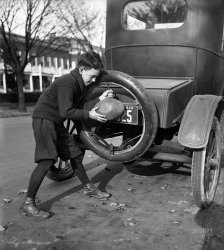
- Shell Company: 1919
- San Francisco, 1919. "Shell Oil Co. service station No. 27." Filling something with something, and smoke 'em if you got ... who worked his way through high school, and beyond, at a gas station you would not believe the number of customers who pulled in with ... Posted by Dave - 12/16/2015 - 1:57pm -
![Shell Company: 1919 San Francisco, 1919. "Shell Oil Co. service station No. 27." Filling something with something, and smoke 'em if you got 'em. 5x7 inch glass negative, formerly of the Wyland Stanley and Marilyn Blaisdell collections. View full size.
Hope That Stogie Ain't LitAs a kid who worked his way through high school, and beyond, at a gas station you would not believe the number of customers who pulled in with lit ciggies and cigars and tried to pump their own gas. Even had a truck with refuse in the back on fire that pulled into the pumps wanting water to put out the flames.
Possibly an economy run?Looks like they're filling a one gallon can with a hose connected to the carburetor. Run it until it quits and record how far it went.
Lundburg Shell Service StationPretty sure this is the Shell station that used to be at the corner of Fell and Stanyan until the 1980s. I was a regular there. The wall in the background looks like the wall along the western edge of Golden Gate Park (though the street was widened in the mid 1900s and the grass shoulder removed).
The shrubbery is trying to tell me somethingThere's a topiary message in the foreground, but I can't tell what it is. Pretty sure it isn't "Shell".
Say it with topiaryIt looks like the low shrubs on the lower left are arranged and trimmed to spell out SHELL.
The Park It Is!StanFlouride pegged the location perfectly. The wall of Golden Gate Park in the background is the giveaway. This Shell station was indeed at the NE corner of Stanyan and Fell Streets.
Here's a Google Maps view of the location today.
It's a familiar scene; I went to high school about three blocks away and walked past the station nearly every day in the 1960s.
Could This BeA picture of Jack Benny before he made the Big Time?
Go Ask AliceThe Mad Hatters at tea.
The CarWhat kind of auto is this? Thanks.
[A Maxwell. - Dave]
(The Gallery, Cars, Trucks, Buses, Gas Stations, San Francisco, W. Stanley)](https://www.shorpy.com/files/images/SHORPY-833A.thumbnail.jpg)
- Filling Station (Colorized): 1907
- ... Company. View full size.
(Colorized Photos, Gas Stations) ... Posted by Dennis Klassen - 02/06/2011 - 7:09pm -
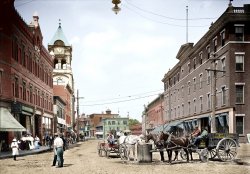
- Richfield Gas Station: c. 1950s
- ... View full size.
(ShorpyBlog, Member Gallery, Gas Stations) ... Posted by Vintagetvs - 09/19/2011 - 2:05pm -
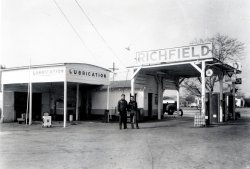
- Jessup's Station
- ... MO, late 1930s. This quaint little sandstone-covered gas station was enlarged in the late '40s, and later razed, replaced by a parking ... Posted by olpossum - 06/27/2021 - 6:35pm -
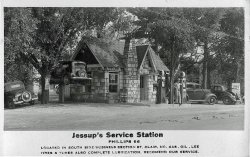
- Gas Station: 1925
- About 1925 my father had built this station in Logan County, Michigan to supplement their farm income. One of their ... Posted by Thomas H Finger - 05/06/2016 - 6:44pm -
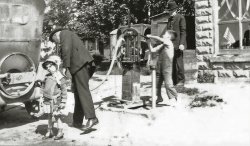
- Minute Service No. 5: 1925
- ... is a beautiful thing. Someone had a good idea there.
Gas and Gas Are those gas street lamps on the street? And yet the station itself seems to have electric lamps around it. Another example of a ... Posted by Dave - 09/11/2011 - 12:23pm -
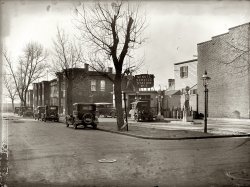
- Foots Whitaker's Station
- ... This undated photo shows Foots Whitaker and his crew at a gas station he managed in the North Birmingham community in Alabama. View full ... Posted by Seay Whitaker - 12/24/2011 - 11:04am -
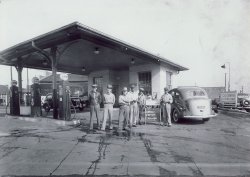
- Pit Stop: 1940
- ... "Cherry pickers. Auto of migrant fruit worker at gas station." 35mm nitrate negative by John Vachon. View full size.
... The sign said, "Clean Rest Rooms," so I did.
Still a gas station there. Michigan Street and Third Ave. The building looks the ... Posted by Dave - 09/14/2011 - 5:47pm -
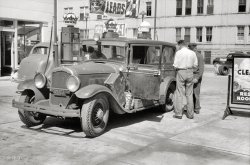
- Western Standard: 1941
- "1935 Ford Tudor sedan at gas station." The year is 1941, and we are somewhere in Southern California. ... the machine. So solid and husky.
That's One Clean Gas Station Not a bit of litter in sight.
The car looks good too.
... Posted by Dave - 02/21/2021 - 12:25pm -
![Western Standard: 1941 "1935 Ford Tudor sedan at gas station." The year is 1941, and we are somewhere in Southern California. Kodachrome by our West Coast "carrespondent" Don Cox. View full size.
I wishsomebody can recognize that art-deco-ish entrance for the location of the pump.
Car design that evokes confidence in the machine. So solid and husky.
That's One Clean Gas StationNot a bit of litter in sight.
The car looks good too.
Ghost ferns?What do you suppose the plants are in the lower right corner? Strange thing!
Kodachrome Automotive BeautyWhat a lovely looking automobile! Wow, I sure miss the days of yesteryear! Too many people on the planet, too homogenous!
Lead WarningGas pumps still had the warning "CONTAINS LEAD" in the 1960's. I never gave it a second thought as I filled up with premium. What were we supposed to do with this information, not drink the leaded gas or not inhale the exhaust fumes? The government was a little less excited about those issues back then, and I was absolutely clueless.
[What you were supposed to do with that information was not employ gasoline for cleaning, heating, cooking or anything else besides its intended use as a motor fuel. - Dave]
Interesting Aftermarket Directional SignalsAftermarket lights on the bumper appear to be directional signals. Factory signals were only introduced on more expensive makes in 1939. This Ford is also in great shape for a six-year-old car in that period.
Spokeless Scene stealing little '35 has been equipped with later rims, clearance/accent lights added above bumper. Ford grille shell nameplate and some side brightwork appears to also have been removed from hood sides? What a sweetie!
https://www.youtube.com/watch?v=sGa59ESP1ps
I've never seen that before. The compressed air and I suppose water hoses imbedded in the pump island are a new one on me. It seems very practical and eliminates a lot of clutter. The little crank to reset the pump counters brings back memories.
The little yellow accessory lights on the bumper of the '35 are nifty. The no frills single windshield wiper, not so much.
Air & Water HosesRob Ellie's comment about the embedded air and water hoses aroused my curiosity. Where is the spring loaded reel that retracts and stores the length of these hoses? There doesn't appear to be an access plate in sight to allow repairs when the storage reels or hoses eventually need repair.
Gramps Would Be ProudMy grandfather (Mom's pop) ended his career as a VP for Standard Oil of California, later known as Chevron, based mainly in San Francisco and worked with both "Company Ops," meaning fully owned and run by the oil company, and the franchisees. He was a complete stickler for having the stations look spotless and if inspected by the company, enough demerits in the looks department could send a manager out the door. This was the norm, especially in stations around the downtown core of cities where there was intense competition. Gas was uniformly cheap, but it was the service aspect of the operation that built loyalty. He would have certainly liked the good and tidy looks of this example, wherever it was.
Lead additiveDave, lead was added to gasoline to reduce engine knocking, boost octane rating and lelp wear and tear on valve seats.
[We know that. The question was the reason for the warning sign. - Dave]
Color Makes it RealThat is beautiful! My first thought: Is that the way things looked back then? I thought everything was black and white." Color brings history a little bit closer to my reality. Thanks Dave.
Grandpa at the GulfSince this picture is from 1941, I recall that my grandpa (Mother's side) ran a Gulf station right here in town from 1941 to '51. Thanks to the local historical society, of which I'm a member, I was able to obtain a nice image of the station, which existed until at least the first few years of my life. I remember well losing Grandpa in 1974, and only wished I'd have been old enough to think to ask him more about his younger days.
(The Gallery, Kodachromes, Cars, Trucks, Buses, Don Cox, Gas Stations)](https://www.shorpy.com/files/images/SHORPY-P-0014.thumbnail.jpg)
- Service Man: 1940
- July 1940. "Gas station attendant. Millburg, Michigan." Medium format acetate negative by John ... ensure that bowtie is straight. Nowadays you would need a gas check and a confined space permit to enter this place if it was in an ... Posted by Dave - 12/27/2019 - 2:34pm -
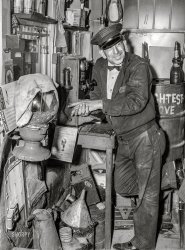
- Ghost Office: 1912
- ... lights It looks like there are two types of lights gas and electric?
[There are two temporary lights wired to the taller ... plate is big (5 x 7 inches). - Dave]
The New Penn Station This wonderful building is slated to be renovated into the New Penn ... Posted by Dave - 12/02/2021 - 2:39pm -
![Ghost Office: 1912 New York's new post office on Eighth Avenue circa 1912. Enlarged in 1934, it's now called the James Farley Building. View full size. In this seemingly deserted time exposure we can see the ghostly images of three different sets of legs.
HauntedMy last 2 posts disappeared in front of my eyes, haunted?
N.Y. Post OfficeNew York General Post Office, now designated the James Farley Post Office, Eighth Avenue between 31st and 33rd Streets.
[Thanks! I added that to the caption. - Dave]
A modern viewYou can see the building as it is now.
The street lightsIt looks like there are two types of lights gas and electric?
[There are two temporary lights wired to the taller ones. - Dave]
Phantom limbsAlso we have three sets of ghost shoes walking down the street. Each footfall makes for kind of a stop-motion effect in this time exposure.
Ghost LegsTo get the image this stunningly sharp he probably set his camera to a very small aperture and because of that and slow film at the time, took a long exposure on a tripod - so that's why you'd see the people walking by.
This is a great find!
[Re "slow film time," there was no film back then for view cameras like the ones that made this picture. They used glass plates coated with emulsion. The image is sharp because the plate is big (5 x 7 inches). - Dave]
The New Penn StationThis wonderful building is slated to be renovated into the New Penn Station, despite much rancor over the conversion. It is situated across from the old Penn Station (by McKim, Mead, and White), which was torn down in the 1960s in favor of the new (and godawful) Madison Square Garden. It was this destruction that spurred Jacqueline Kennedy to save Grand Central Terminal, which was also slated for destruction.
(The Gallery, G.G. Bain, NYC)](https://www.shorpy.com/files/images/SHORPY-15004u1.thumbnail.jpg)
- Hamilton: 1942
- ... Office of War Information. View full size.
Passed Gas (station) Today, the major change is that the gas station has been replaced - ... Posted by Dave - 10/21/2021 - 10:25am -
![Hamilton: 1942 April 1942. "Hamilton, Ravalli County, Montana." At the Montana Cafe: "Good Eats." Medium format acetate negative by John Vachon for the Office of War Information. View full size.
Passed Gas (station)Today, the major change is that the gas station has been replaced - not the other was around for once !! - by a building that looks almost as old as this photo.
https://www.google.com/maps/@46.2470347,-114.1565847,3a,60y,329h,100.87t/data=!3m6!1e1!3m4!1sFsPTzGIyaBHFlbQyW8dbbA!2e0!7i13312!8i6656
Still thereThe JC Penney's building is still there.
https://www.google.com/maps/@46.2470347,-114.1565847,3a,90y,320.98h,90.91t/data=!3m6!1e1!3m4!1sFsPTzGIyaBHFlbQyW8dbbA!2e0!7i13312!8i6656
As Seen on 2018 OctoberHere's Google Street View of approximately the same location taken in October of 2018. https://goo.gl/maps/4MSJgbY4h8TtTCiU6
Bet they wished- - they had kept those streetlights, they did not !
Mostly intact.https://goo.gl/maps/Andk1QMEwJneevbK7
*Sigh*Who will be the first commenter to correctly embed a Street View of 21st-century Hamilton?
A True PioneerPenney's had the foresight to lock down their website decades before we were blessed with computers.
Dave, here is a testThis should embed a map Hamilton but it isn't working. The address Google supplies to embed doesn't look the same as it usually does. Just FYI.
[Don't use an "a href" tag. Simply copy and paste the code google gives you, as I've done below. - Dave]
Thank you, Dave. It's 6AM the next day and after sleeping I realize I overthought the problem. I wish I could say it's the first time I've done that.
More Good EatsGreat article about the cafe, and the sign lit up!
(The Gallery, Gas Stations, John Vachon, Small Towns, Stores & Markets)](https://www.shorpy.com/files/images/SHORPY-8c21979a.thumbnail.jpg)
- Chicago: 1915
- Chicago circa 1915. "Van Buren Street Station. View north along Michigan Avenue." 8x10 inch glass negative, Detroit ... Fe Center) at left, built 1903-1904, and the People's Gas Building at right, built 1910-1911. The two-bay "penthouse" perched atop ... northeast corner, visible in this pic.
The Glass Gas Ceiling The big white building in front of the Art Institute is the ... Posted by Dave - 07/30/2012 - 10:07pm -
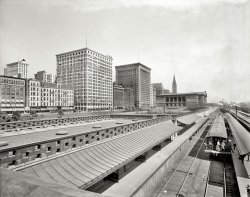
- Q Street Gas: 1920
- ...
27th and Q, NW Ads from 1920 indicate a Penn Oil station located at 27th and Q streets NW.
I've added this photo to my ... It's so hard to fill up with the invisible kind.
Gas 30-Cents a Gallon in 1920? Gas cost too much in 1920. Thirty cents a ... Posted by Dave - 09/11/2011 - 6:51pm -
![Q Street Gas: 1920 Washington, D.C., circa 1920. "Penn Oil, Q Street, Georgetown." View full size. National Photo Company Collection glass negative, Library of Congress.
27th and Q, NWAds from 1920 indicate a Penn Oil station located at 27th and Q streets NW.
I've added this photo to my growing Google Map Mashup of Shorpy's D.C. area photos.
Visible GasolineGood to see that they're selling "Visible Gasoline." It's so hard to fill up with the invisible kind.
Gas 30-Cents a Gallon in 1920?Gas cost too much in 1920. Thirty cents a gallon?
Heck, on the corner of 13 Mile Road and Ryan Road in Warren, Michigan, during the late 1960's, we could get gas for 19-cents a gallon during the "Gas Wars".
Not only that - we could get an inflatable Dino the Dinosaur (Sinclair), a full set of Detroit Tigers Glasses (Marathon) and other stuff I've forgotten from Standard (Amoco) and Gulf.
Those 1960's "Gas Wars" - those were the good ole days. Forget that 1920's nonsense. How could a poor Flapper gal get about with the cost of gas?
Tiger in Your TankDon't forget the 1960s Esso "Tiger in Your Tank" Tail to hang from your gas cap. That was worth a fill-up.
Wow, Shorpy Shrinks The World!I grew up in Warren, Michigan (11 mile & Mound) and also remember the "Gas Wars." My mother had a fit when she moved me into MSU. Gas was 69 cents a gallon just off campus. My going to college was going to send her "to the poorhouse."
A Gallon of GasIn current dollars the price of gas in 1920 was $ 2.75 per gallon - almost the highest price on the graph. About ~5 years later when flappers drove up to the filling stations and stepped out of their Ford roadsters wearing high heels, the station was (hopefully) paved and the price had significantly dropped. So there was spending money left for make-up, cigarettes and filling the hip flasks.
[It's interesting to note that for 50 years the absolute price of a gallon of gas stayed pretty much the same -- 20 to 25 cents from 1920 to 1970. - Dave]
Chart: New York Times (Click to enlarge)
Washington MonumentYou can see the top of the Washington Monument on the right. That must mean this was on the south side of Q. Probably near Kew Gardens, which I think was already built around then.
Gas Prices Over the AgesThirty cent gas in 1920 is equal to $3.10 a gallon today. I'd be happy to pay that, and so would my poor Flapper gal.
Bleak Station; Free AirThis enterprise presents a bleak vision, with its blank sign on our left, the stakes dancing around the small evergreens out front, the bare limbed tree, and the near-desperate appearing proprietor.
I wonderIf that's the site of the selfsame station that was in Georgetown when I went to school there--it was a really old-fashioned one that may have been closed.
Visible GasThe old system of filling your tank used a hand pump to pull the gas out of an underground tank and into the glass beaker on top of the pump. That beaker had painted lines on the side which told you how much gas you were paying for.
You can see both the hand pump and the glass beaker. Notice the chicken wire around the beaker to ward off rock throwers.
Gas on the cheap In the early sixties, I worked at an independent gas station that closed its bays and installed a dozen double pumps, then they offered gas for 30 cents a gallon, about half price. The place was mobbed all day, plus they gave out colored chips with each purchase that could be redeemed for dishes, lighters and bric-a-brac. My friend Bob and I spent a whole blazing summer out there wearing aprons full of chips and pumping like a tornado was coming. Those two fellows probably prayed for business like that.
(The Gallery, D.C., Gas Stations, Natl Photo)](https://www.shorpy.com/files/images/29662u.thumbnail.jpg)
- Grassy Butte: 1936
- ... Roosevelt's tour there. View full size.
Still a gas station there But the original buildings are, no surprise, gone.
Love ... Posted by Dave - 07/28/2012 - 2:24pm -
![Grassy Butte: 1936 July 1936. "Grassy Butte. The drought area of North Dakota." One of dozens of photos snapped by Arthur Rothstein of the Dust Bowl-era Midwest during the summer of Franklin Roosevelt's tour there. View full size.
Still a gas station thereBut the original buildings are, no surprise, gone.
Love That 17 Cent GasI had to say it!
Lots of competitionLooks like two Hardware Stores, Two General Stores and at least three Gas Stations in this little place.
Three gas stationsThe primary business in town seems to be pumping gas.
"Sure don't look none too prosperous"A quote from Tom Joad. Although a couple of years before its publication, this photo makes me think of Grapes of Wrath. This little town is also north of Steinbeck's Joad family's travels along Route 66 from Oklahoma. I think the gas pumps on the opposite side are Phillips 66 though, which received its name from the Phillips brothers when their gasoline was tested on Route 66 and the test auto went 66 mph.
The Dust Bowl It was in 1936 when my mother's family gave they're farm in Scottsbluff, Nebraska back to the bank and moved to California. She was 9 at the time and had a lot of memories of the trip, none of them bad, even though I am sure it very hard.
+76Only one brand of gas, down from the previous three. I would have loved to step inside Robert Evans' hardware store, but I bet the locals now drive 40 miles to the Wal-Mart in Dickinson.
Bad day at......Grassy Butte.
Keep an eye out for a one-armed man getting off the train!
[Well done on the Spencer Tracy film reference! - tterrace]
That was a place and timeNorth Dakota 1935-'36 - when the Earth basically said, "Die," to the people.
The previous winter ranged down to -60°F and one N.D. town reported six solid months where the temperature didn't rise above freezing. Then came the summer of '36 and the second killer depression heat wave - and again it was N.D. that got the worst, with a national record high of 121° that July.
That's 181° in temperature variation from midwinter to midsummer - probably more than any place outside Siberia then or now.
Beer signIf you look at the full-size version, and blow it up a little, you see three Stroh's Beer signs on the "Meals and Lunches" building. They have "Stroh's" in the normal script with "beer" in block caps, both in white, with a solid dark six-pointed star as background. This is the first time I've seen this Stroh's logo, and a quick search of the net didn't turn up any other examples. Perhaps unique to a particular distributor?
[It's for Gluek's. -tterrace]
Gluek Beer(say "Glick") was brewed in Minneapolis from 1857 to 1964, and later on in Cold Spring, Minn. Today it is brewed exclusively for Gluek's Restaurant in Minneapolis.
(The Gallery, Arthur Rothstein, Dust Bowl, Gas Stations)](https://www.shorpy.com/files/images/SHORPY_8b28081a.thumbnail.jpg)
- Old-Timer: 1937
- ... effects of the great Ohio River flood of 1937.
Shell station And it appears there's a Shell gas station across the street, thanks to the reflection, bringing this somewhat ... Posted by Dave - 11/14/2012 - 6:28pm -
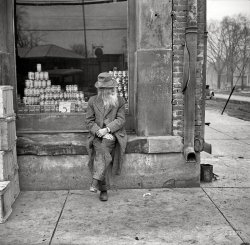
- Filtered Gasoline: 1920
- ... that magazine, giving an unusually detailed look at the gas station (and gas pump) of a century ago. 8x10 inch glass negative. View full ... Posted by Dave - 09/09/2014 - 11:28am -
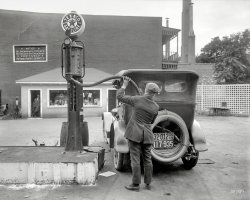
- Self-Service: 1920
- ... D.C., 1920. "Nation's Business." Back at the filling station seen here yesterday. 8x10 inch glass negative by Harris & ... only did the brand name change, but the sign touting clean gas moved from the wall behind the station to the other side of the station. ... Posted by Dave - 09/10/2014 - 4:42pm -
![Self-Service: 1920 Washington, D.C., 1920. "Nation's Business." Back at the filling station seen here yesterday. 8x10 inch glass negative by Harris & Ewing. View full size.
*POSITIVELY*Do you think people actually bought the sign's message about dirt or water in the fuel? In my lifetime, most of the contamination of fuel occurred at the station's tanks, not before. Marketing-speak!
Innovation -- Not!The post-'73 oil crisis tendency for US gasoline sales to become largely self-service (except for the handicapped, those willing to pay a hefty surcharge, and anyone purchasing fuel in New Jersey) apparently revives a much older practice, as the two photos in this series attest. My own memories date from the mid-1940s, and self-service was by then unknown in any place where I witnessed cars' being refueled.
One wonders not why the practice was revived but, rather, why it was abandoned for so long?
Not same dates in 1920It seems that not only did the brand name change, but the sign touting clean gas moved from the wall behind the station to the other side of the station.
[The sign is suspended from a wire strung between the two gas pumps. -tterrace]
You can trust your car --Huh, I could've sworn this was a Texaco dealer just yesterday.
That wallIs screaming for the sign painter's touch.
You too can pump your gas like thatIf you have a hankering to have your gas put into your tank using the amazing force of _GRAVITY_, there is a resort (I forget the name) on road into Kings Canyon National Park in California that has not one, but two, working pumps just like the one in the picture.
Dodge BrothersThe old Dodge looks much spiffier with the optional wire wheels.
Cars, and such1920 Dodge, maybe a little earlier. Model T or TT in the background.
Interestingly, Wikipedia dates coveralls to the late 1920s but they seem to be fairly common in earlier-than-that Shorpy photos. Anyone know when they were really introduced?
Cameo appearancesTurnbuckle star! Also, Dick Cheney.
Two brands at the same station?So the pump on the right had Texaco gas and the one on the left Standard gas? Maybe they were owned by the same company at one time; don't recall my oil company history the way I used to.
SpiffyThe wheels may be spiffy with those wire wheels, but the tires look like bicycle tires! They look like they might collapse at the first big pothole.
(The Gallery, Cars, Trucks, Buses, D.C., Gas Stations, Harris + Ewing)](https://www.shorpy.com/files/images/SHORPY-20707a.thumbnail.jpg)
- More Mystic: 1940
- ... Administration. View full size.
Well, the Mobil station is still there The streetview vision of this is just too depressing, ...
And the fine folks of Mobil Oil still have their gas station. The following for those of you who wish Mr. Delano had pointed his ... Posted by Dave - 01/16/2019 - 10:38pm -
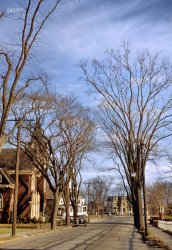
- Rusty Tailpipes: 1960
- ...
Still Muffling John Holland's Texaco service station at 319 13th Street is long gone, Midased right off the map. The brick ... or something to identify this location (Holland Service Station didn't do the trick). Then I got stuck on this. What is that?
...
(The Gallery, Cars, Trucks, Buses, Columbus, Ga., Gas Stations, News Photo Archive) ... Posted by Dave - 06/04/2022 - 9:02pm -
![Rusty Tailpipes: 1960 From circa 1960 Columbus, Georgia, comes this News Archive photo of a Midas Muffler Shop next to Holland's Texaco service. Fill 'er up with Su-Preme! 4x5 acetate negative. View full size.
Still MufflingJohn Holland's Texaco service station at 319 13th Street is long gone, Midased right off the map. The brick building across the street still stands, taller and longer.
"Let us Marfak your car" "A properly lubed auto will bring $75 to $100 more when you trade it in after 2-3 years." So says the Marfak advertising of the day. "The Green Grease that doesn't wash out on wet roads or melt on hot days."
What is that?I was searching, without luck, to find a street number or something to identify this location (Holland Service Station didn't do the trick). Then I got stuck on this. What is that?
[You mean the thing that looks a like a giant muffler? Right next to the sign that says MUFFLER SHOP? Hmmm. - Dave]
Yes! That thing! What is it? Of course you're correct. I wasn't thinking in terms of 1960s-style advertising. You just brought back some memories.
I looked it upAs Steve Belcher pointed out, Marfak was both a product and a process, the name of which, in advertising at least, was used as a verb. According to BrandlandUSA dot com: One of the more forgotten sub-brands of a major oil company is Marfak Lubrication. Marfak was the lube brand of Texaco and Caltex. If Havoline was the actual oil, Marfak was the process. I can’t say it was actually used much as a verb, as I never heard the word used; I only saw it above station bays. But the slogan was “Let Us Marfak Your Car.”
Thanks for that! p.s. When my daughter lived in Williamsport, Pennsylvania for several years after her marriage, I used to drive through Lewisburg every couple of months when I went to visit her! Lovely drive along the Susquehanna.
Can-do attitude at work?I find it hard to believe a news photographer got extra points back in the newsroom for including three garbage cans so prominently in the foreground. I also suspect proprietors of the two businesses were less than thrilled with this all-inclusive view.
[Photos get cropped before publication. These are scans of the uncropped negatives. -Dave]
Put a muffler on them cans!!!I remember when I was a kid, the guys in the trash truck would have to first wrestle the lid off and lift the can up, tip it over then bang the sides of the can on the truck to make sure everything was out. That was really loud, especially early in the morning! So yeah, the cans could have used a muffler from the friendly folks at the Muffler Shop.
BUT,not a Milton Signal Hose in sight?
Avert your gaze!Forget those trash cans, what about that Medusa's head over in the corner?
"I've Been Marfaked!"... As heard in Ghostbusters, the Shorpy Director's Cut.
Hat tip to Steve Belcher for the comment about the Marfak advertising: "The Green Grease that doesn't wash out on wet roads or melt on hot days."
Some Like it HotAll you need to know about Marfak grease is in this Australian TV commercial from 1961.
(The Gallery, Cars, Trucks, Buses, Columbus, Ga., Gas Stations, News Photo Archive)](https://www.shorpy.com/files/images/SHORPY-1688A.thumbnail.jpg)
- Verified Lubrication: 1939
- 1939. "Service station in Washington, D.C." Continuing today's Essorama. 35mm nitrate negative ... I wonder if those seven oil pump dispensers between the gas pumps are there year-round? I'd hate to be the grease monkey who has to ...
(The Gallery, Cars, Trucks, Buses, D.C., David Myers, Gas Stations) ... Posted by Dave - 02/27/2013 - 6:06pm -
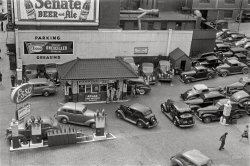
- The Good Gulf Gas Man
- My father at the grand opening of his Gulf Gas station in Gulfport, Miss., circa 1955. You will notice that as a former U.S. ... Posted by DoninVa - 09/20/2011 - 9:19pm -
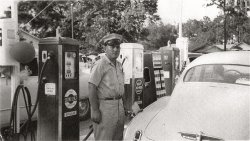
- Pittsburgh: 1941
- ... photo is a parklet called Morrow Triangle. The filling station and church are now the site of a car dealer. Unless there was a street ... thought that Atlantic sign was a street. It looks like a gas station to me, or something else.
It's Deutschtown This is the ... Posted by Dave - 01/17/2023 - 2:46pm -
![Pittsburgh: 1941 June 1941. "Rain. Pittsburgh, Pennsylvania." Medium format acetate negative by John Vachon for the Farm Security Administration. View full size.
I love the rain...This photo immediately brings forth the smell of rain, the hiss of car tires as they pass and the drip drip drip of rainwater off the eaves of the porch.
Pittsburgh by VachonThis is a beautiful picture. John Vachon's photos did not have the pathos and personal drama of Dorothea Lange's work, but more than any other American photographer, he has left an invaluable scrapbook of the vernacular American landscape. He is my favorite photographer.
What are the towers ...... in the background? Is that another church? Looks Orthodox. Perhaps someone familiar with Pittsburgh will know.
A Rainy DayThe person walking with the umbrella really makes the photograph work. You can almost feel the rain..
Pittsburgh PrecipitationI agree with others here about the evocative quality of this photo. Staring at this for a few moments I swear I can hear the rain coming down!
Canada Dry SpurCanada Dry Spur ("the cola drink with Canada Dry quality") was Canada Dry's attempt at entering the cola wars. By this time of course the company was owned by P.D. Saylor and Associates and the only connection with Canada was the name.
Such a wonderIt's 103 degrees on my front porch (yes, that's in the shade), my part of Arizona hasn't seen rain in 3 or 4 months. Guess whats going on my desktop. Thanks.
DSS
Look how it falls straight down!Not only can I relate to DSS since we don't get a lot of rain in West Texas, but I'm just amazed at how it's coming *straight down*. (Huge gusts of wind aren't sucking her umbrella inside out, and the rain isn't coming in sideways and raising welts on her skin!)
P.S. Not that I'm complaining...I love it here, and my glasses usually protect my eyes from the infrequent SIDEWAYS rainstorms!
Tioga Street, PittsburghPittsburgh has a lot of onion-dome ethnic churches all over town. The 1941 City Directory lists a Wm. James Confectionery at 7314 Tioga Street, which is where Point Breeze meets Homewood meets nothing original still standing. This would be east of downtown.
South Side P-BurgThis looks like the "South Side" of Pittsburgh and if I am not mistaken, this is an orthodox church which is now the private home and studio of the owner of the number one Pittsburgh chain of hair salons and spas.
Morrow TriangleAtlantic ave is a one-way northward running street to the east of downtown. The only intersection that makes a bend like the one photographed is at Liberty and Baum. There are no row homes or churches there now though.
The vantage point of the photo is a parklet called Morrow Triangle. The filling station and church are now the site of a car dealer. Unless there was a street name change that the Atlantic ave in the picture is different from the current Atlantic ave I think I'm right.
[The "Atlantic" sign is advertising a brand of gasoline. - Dave]
It's SouthsideI've lived in Pittsburgh all my life and this shot looks remarkably like the Southside (flats) to me just off Carson Street. Many churches of similar Greek Orthodox venue there. A previous poster indicated he thought that Atlantic sign was a street. It looks like a gas station to me, or something else.
It's DeutschtownThis is the corner of Madison and Lockhart, looking west. The church with the onion domes is St. Mary's -- Bavarian Catholic, believe it or not.
You can't go and see this intersection anymore since it was destroyed in the 1980s so that the Parkway North could be built. The church is still there, although now it's a hotel.
Pressley StreetThe previous comment is correct. That's St. Mary's (now known as the Priory) which sits at 614 Pressley Street.
Atlantic GasThe Atlantic sign is for the gas station. Atlantic petroleum was founded in Philly, then eventually acquired by Sunoco in the 80's or 90's.
(The Gallery, John Vachon, Pittsburgh)](https://www.shorpy.com/files/images/SHORPY-8c19363a.thumbnail.jpg)
- One Second Fast: 1943
- ... circling buzzards (really), and inbred locals (at a remote gas pipeline station), (1) meth-addled trucker, and (2) tow-truck drivers sharing graphic ... Posted by Dave - 09/05/2012 - 6:06pm -
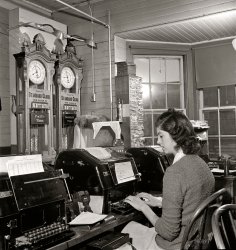
- Backstage With Elvis: 1956
- ... It looks like Tri-X, from the grain.
The King at the gas station My agent back in Denver ran into Elvis at a gas station in Needles ... Posted by Dave - 03/11/2013 - 6:40pm -
